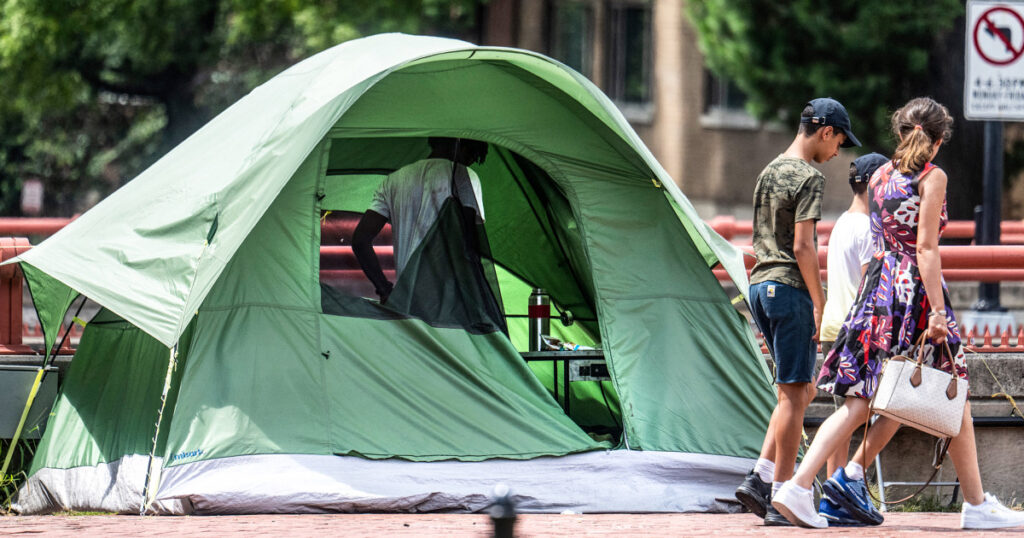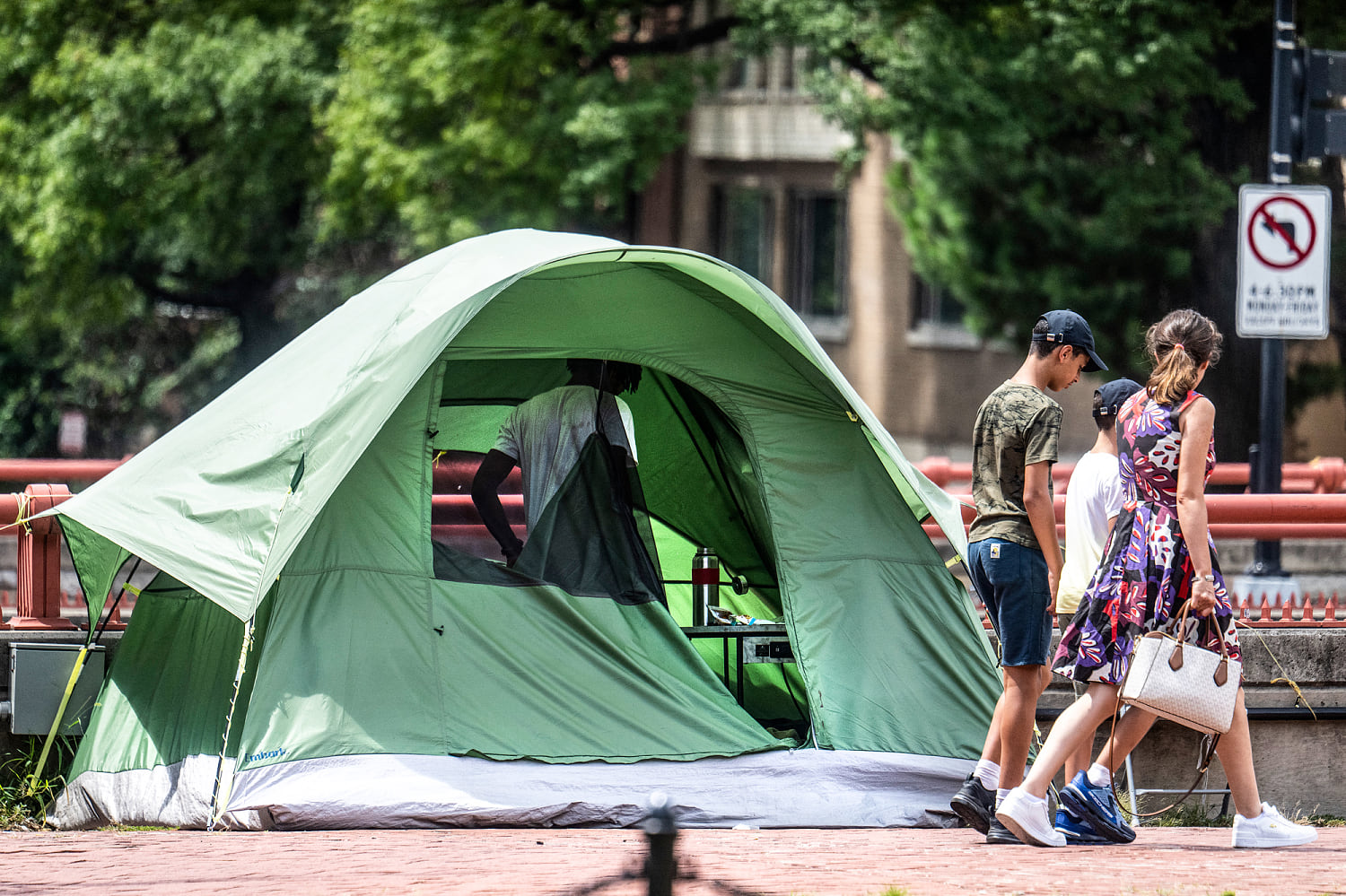

About 70 homeless encampments in the nation’s capital have been taken down in recent months, but those efforts intensified this week after President Donald Trump deployed members of the National Guard to address what he said was a city “overtaken by violent gangs and bloodthirsty criminals, roving mobs of wild youth, drugged out maniacs and homeless people.”
On Thursday, a homeless encampment near the Kennedy Center — for which Trump serves as chairman — was dismantled by city workers who shoved people’s belongings into garbage trucks.
The president’s move comes as crime and homelessness are both reported at or near decade lows in D.C. So how dire is the city’s homeless situation? Here is a breakdown of some of the data.
Homelessness in D.C. has been declining in the long run, but has fluctuated in recent years
The latest city numbers show that as of 2025, about 5,000 people are in shelters or on the streets of D.C., a decrease of 9% from 2024.
The city is an outlier: Most of the rest of the country has had increases in their homeless population in recent years.
Compared to changes in the national homeless population, D.C. is unusual. As national numbers have increased, the District of Columbia’s have fallen.
The figures show a significant drop over the last decade in D.C.; in 2016, more than 8,000 people were unhoused, though there have been fluctuations over recent years, in part due to the Covid-19 pandemic.
D.C.’s homeless count hit a low in 2022 as the government issued rapid rehousing vouchers. This emergency funding from the Biden administration provided housing for people, including in vacant hotels.
“The numbers came down in 2022 when there was actual housing taking place,” said Hilary Silver, a professor of sociology, international affairs and public policy at George Washington University. “And then that money ran out.”
The District’s homeless population rose from 4,922 individuals in 2023 to 5,615 in 2024, according to the U.S. Department of Housing and Urban Development’s point-in-time count of homeless people. Most of Washington, D.C.’s homeless population is concentrated in busy, central areas where tourists and residents intersect, including downtown, Union Station, Georgetown and Foggy Bottom, Silver said.
Nationwide, more than 770,000 people were homeless in 2024, according to the HUD data.
Which populations are most affected by homelessness?
For a city whose population is 41% Black, D.C.’s homeless population is disproportionately Black, at 82.5%. Compare that to the city’s white population: 39.6%, with 6.6% homeless, according to the U.S. Census Bureau. Sixty percent of all homeless people are men.
When it comes to age, 7.9% of Washington, D.C.’s homelessness population are senior citizens — compared with 5.5% of the national population. Also, 18.6% of those who are homeless are under 18, according to an NBC News analysis of HUD data.
Experts attribute homelessness in D.C. to a lack of affordable housing, a shortage of jobs that pay livable wages and the high cost of living.
According to Apartments.com data, the cost of living in Washington is 40% higher than the national average and housing costs are more than double the national average.
Challenges particular to D.C.’s Black homeless population include higher rates of disability, eviction and poverty, along with experiencing racial discrimination, Silver said.
“Part of it is the difficulties that African Americans always face in the housing market, but also in the labor market,” Silver said. “They live in neighborhoods where the housing is not in very good condition.” People who become homeless are either evicted or forced out of their homes and then stay with friends and family. But “after a while,” Silver added, “they outlive their welcome.”
How was D.C. addressing homelessness before Trump’s order?
Donald Whitehead Jr., the executive director of the National Coalition for the Homeless, attributes the drop in homelessness in the city this year to supportive housing and targeting homeless youth in the region.
“D.C. has an advantage over many communities with the resources that are available,” Whitehead said. “D.C. had considerably more housing vouchers than other communities. There has been a lot of work around making sure people were protected within the system.”
Some programs include D.C. Flex, which provides low-income working families with $8,400 per year for up to five years. There’s also the Tenant Opportunity to Purchase Act that allows tenants the right to purchase their building if it is being sold.
Given how effective these programs have been, both Silver and Whitehead said that the dismantling of the district’s homeless encampments will not address the root causes of homelessness.
“I think it demonizes people,” Whitehead said. “It minimizes their humanity. We know that when there is a lot of conversation about people experiencing homelessness in a negative way, we see the increase of violence against that population.”
While encampment sweeps are nothing new to Washington, those efforts increased in March. Silver said the sweeps make it difficult for outreach teams to track and help homeless individuals. Instead of clearing such encampments, experts advocate for more funding from the federal government, higher wages and more affordable housing. This includes the “Housing First” approach, a model that prioritizes permanent housing to homeless individuals so they can go after their goals and have a better quality of life.
“We promote Housing First in the district, because when people have a place — a stable place to stay — then it’s easier for them to receive the services that are available,” she said.
 Latest World Breaking News Online News Portal
Latest World Breaking News Online News Portal






